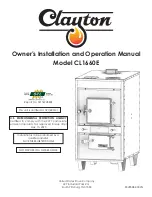
22
TRANSITION NO LESS
THAN 45 DEGREES TO
HORIZONTAL PLANE TO
AVOID CREATING A WATER
TRAP IN VENT PIPING.
ACCEPTABLE
NO TRANSITION ON
HORIZONTAL PLANE,
THIS CREATES A
WATER TRAP AND
RESTRICTS FLUE
GASES
Precautions should be taken to prevent condensate from freezing
inside the vent/flue pipe and/or at the vent/flue pipe termination.
All vent/flue piping exposed to temperatures below 35°F (2°C)
for extended periods of time must be insulated with 1/2” thick
closed cell foam. Also all vent/flue piping exposed outdoors in
excess of the terminations shown in this manual (or in unheated
areas) must be insulated with 1/2” thick closed cell foam. In-
spect piping for leaks prior to installing insulation.
T
ERMINATION
L
OCATIONS
NOTE:
Refer to
Location Requirements and Considerations
for
combustion air contaminant restrictions.
The following bullets and diagram describe the restrictions con-
cerning the appropriate location of vent/flue pipe and combustion
air intake pipe (when applicable) terminations. Refer to
Non-Di-
rect Vent (Single Pipe) Piping
and
Direct Vent (Dual Pipe) Piping
located in this section for specific details on termination con-
struction.
•
All terminations (flue and/or intake) must be located at
least 12 inches above ground level or the anticipated snow
level.
•
Vent terminations (non-direct and direct vent) must termi-
nate at least 3 feet above any forced air inlet located within
10 feet.
NOTE:
This provision does not apply to the combustion
air intake termination of a direct vent application.
•
The vent termination of a
non-direct
vent
application must
terminate at least 4 feet below, 4 feet horizontally from, or
1 foot above any door, window, or gravity air inlet into any
building.
•
The vent termination of a
direct vent
application must ter-
minate at least 12 inches from any opening through which
flue gases may enter a building (door, window, or gravity
air inlet).
•
The vent termination of vent pipe run vertically through a
roof must terminate at least 12 inches above the roof line
(or the anticipated snow level) and be at least 12 inches
from any vertical wall (including any anticipated snow build
up).
•
A vent termination shall not terminate over public walk-
ways or over an area where condensate or vapor could
create a nuisance or hazard or could be detrimental to the
operation of regulators, relief valves, or other equipment.
•
The combustion air intake termination of a direct vent ap-
plication should not terminate in an area which is frequently
dusty or dirty.
Non-Direct Vent
Vent/Flue Termination
No Terminations
Above Walkway
4'
min.
Non-Direct Vent
Vent/Flue Termination
Direct Vent
Vent/Flue Termination
Forced Air
Inlet
Non-Direct Vent
&
Direct Vent
Vent/Flue Terminations
Grade or Highest
Anticipated
Snow Level
12" min.
4' min.
12" min.
Vent Termination Clearances
NOTE:
In Canada, the CAN/CSA B149 Gas Installation Code
takes precedence over the preceding termination restrictions.
PRODUCT DESIGN
















































